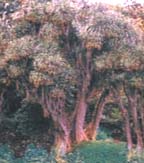 Dracaena draco
Dracaena draco
Dragon Tree
This tree is related to
Ladon, an ancient dragon with a hundred heads,
each of which spoke in a different voice. When
Juno was married, Gaia gave her three golden
apples as a present. Juno put them in the Garden
of the Hesperides and set Ladon to guard them.
Herakles intended to steal the apples and killed
Ladon. From the creature's blood sprang these
trees. Juno rewarded the dragon by putting him
among the stars as the constellation Draco, which
wraps itself around the North Pole like Ladon
wrapped itself around the trees in the garden. One
of its stars, Thuban (Arabic for "dragon"), was
the Pole Star around 2700 BC, when Ladon's story
was first being told. The pyramid of Khufu
contains a passage that was built to point at
Thuban. Magickally, this
Mars tree is
excellent for defense and for boosting the power
of any work. Top
 This exotic tree is a native
of the Canary Islands, Madeira, the Cape Verde
Islands, and the Atlas Mountains in Morocco. The
natives of the Canary Islands harvested the resin
of these trees for mummification. They made
shields of its bark, colored their hair red with
its leaves, and hollowed out dead trees for
beehives (lots of nice Mars connections here). The
odd branch formations resemble the hundred heads
of the dragon. Fossils of this tree have been
found in southern France. It probably grew
along the coast of the Tethys Sea, which once
separated Africa and Eurasia and shrank to become
the Mediterranean. During the Spanish Conquest,
dragon trees were over-harvested; nowadays they
are very scarce in their native areas and are
protected. The red resin of this tree is
richly fragrant and of a much higher quality than
the resin from Calamus draco--it is almost
impossible to find on the market at all.
Top
This exotic tree is a native
of the Canary Islands, Madeira, the Cape Verde
Islands, and the Atlas Mountains in Morocco. The
natives of the Canary Islands harvested the resin
of these trees for mummification. They made
shields of its bark, colored their hair red with
its leaves, and hollowed out dead trees for
beehives (lots of nice Mars connections here). The
odd branch formations resemble the hundred heads
of the dragon. Fossils of this tree have been
found in southern France. It probably grew
along the coast of the Tethys Sea, which once
separated Africa and Eurasia and shrank to become
the Mediterranean. During the Spanish Conquest,
dragon trees were over-harvested; nowadays they
are very scarce in their native areas and are
protected. The red resin of this tree is
richly fragrant and of a much higher quality than
the resin from Calamus draco--it is almost
impossible to find on the market at all.
Top
 When it is young, the dragon
tree looks more like an agave--a bunch of upward
pointing sword-shaped leaves (leaves can be up to
2 ft long). As it ages, it resembles a sort of
palm with a bunch of spiked leaves at the top
instead of fronds. Its mature shape is tree-like,
with all the branches ending at the same line,
like an inside-out umbrella, and it develops
thick aerial roots. (illustration shows a
mature tree used as a house). This plant is very
slow growing--it can take 10 years to reach a
height of 2-3 feet (its maximum height is 30 ft).
Every time it flowers (greenish-white blooms are
fragrant), it branches, which causes the
hundred-headed effect. It resists bugs well and
when mature is very resistant to fire (which again
makes a nice Mars connection). It is not for
instant gardens but an investment in the future,
representing the gardener's hope and trust.
Instead of harvesting the resin from the main
trunk, which can damage a young tree, try
harvesting the leaves sparingly.
Top When it is young, the dragon
tree looks more like an agave--a bunch of upward
pointing sword-shaped leaves (leaves can be up to
2 ft long). As it ages, it resembles a sort of
palm with a bunch of spiked leaves at the top
instead of fronds. Its mature shape is tree-like,
with all the branches ending at the same line,
like an inside-out umbrella, and it develops
thick aerial roots. (illustration shows a
mature tree used as a house). This plant is very
slow growing--it can take 10 years to reach a
height of 2-3 feet (its maximum height is 30 ft).
Every time it flowers (greenish-white blooms are
fragrant), it branches, which causes the
hundred-headed effect. It resists bugs well and
when mature is very resistant to fire (which again
makes a nice Mars connection). It is not for
instant gardens but an investment in the future,
representing the gardener's hope and trust.
Instead of harvesting the resin from the main
trunk, which can damage a young tree, try
harvesting the leaves sparingly.
Top
How to grow
Dragon Tree: Sow in winter,
fall, or spring. Wet a small amount of peat moss
so that when it is squeezed, only a couple drops
come out. Mix seeds in with that and put in a
ziplock bag and keep at 65-85F. Seeds should
germinate in one month. Then pot them in a mixture
of peat and sterile potting soil--this plant hates
compost. Grow indoors in a sunny window with good
ventilation or outside in partial sun in zones
9-12 (hardy only to 22F/-5C). This plant grows
well in coastal southern California south to
Mexico. Despite loving warmth, it should be
protected from very intense afternoon sunlight, as
in Arizona, and if grown inland, protect them from
drying winds.
General
growing information
Top
|
Dracaena draco
Dragon tree
10 seeds $4.00
Uses in
Witchcraft & Magic:
Protection Spells
Potentiating
Any Work
Mars Herb
© 2004-2024 Alchemy Works; No
reproduction without permission
|